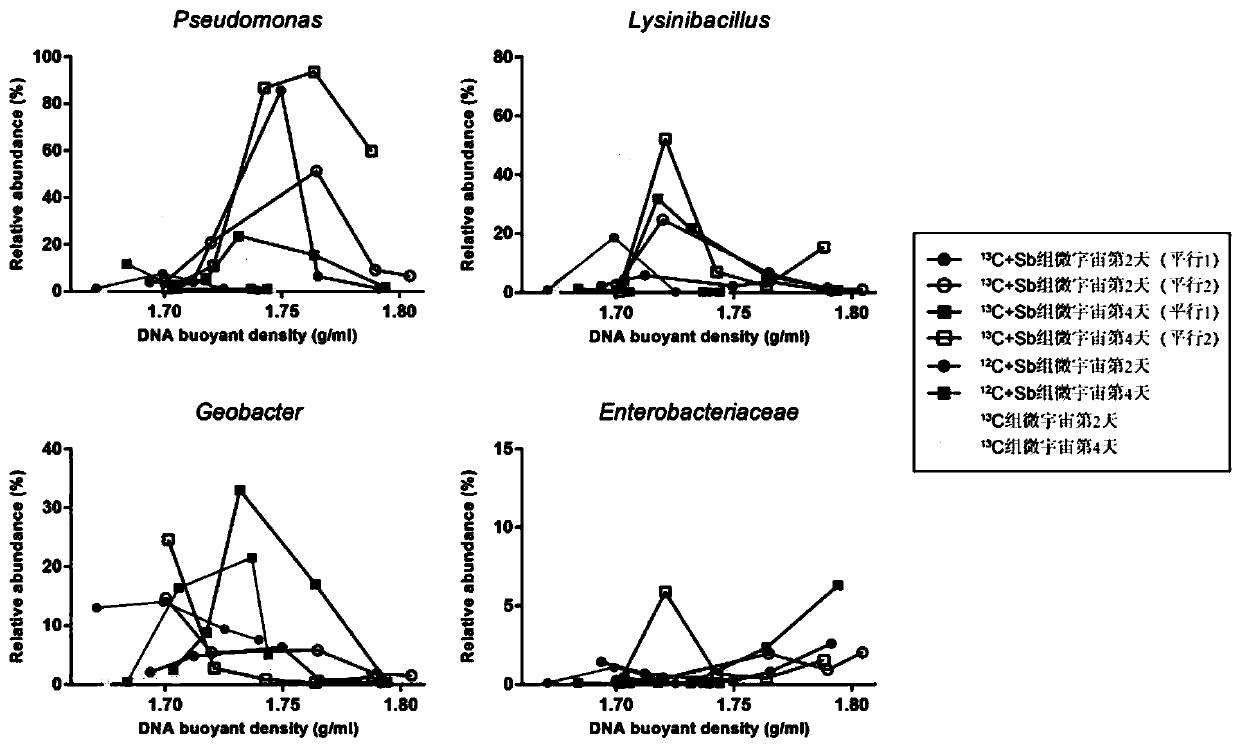Method for judging strain participating in antimony reduction process in soil and key function gene of strain
A technology of soil and bacteria, applied in the field of soil microbial ecology, can solve the problem of inability to distinguish alienated respiratory bacteria, and achieve the effect of simplifying the structure
- Summary
- Abstract
- Description
- Claims
- Application Information
AI Technical Summary
Problems solved by technology
Method used
Image
Examples
Embodiment 1
[0042] DNA-SIP identification of antimony-reducing bacteria in paddy soil includes the following steps:
[0043] (1) Sample collection and processing
[0044] Soil samples were collected near a mining antimony mine in Hechi, Guangxi. Paddy soil polluted by antimony for a long time has formed a selectivity for microbiota, which may be enriched in antimony metabolizing microorganisms. It was collected in paddy soil at a depth of 5-10 cm on the surface Samples were stored at low temperature and shipped to the laboratory.
[0045] (2) Establish DNA-SIP Microcosm Cultivation System
[0046] Three groups of microcosmic systems were established with the collected rice field soil samples. The microcosmic system was established with a 160mL sterilized serum bottle, and about 1g of soil and 100mL of mineral salt solution (Mineral Salts Medium, MSM) were added to the bottle, and injected into the bottle N 2 Purging keeps the microcosm system in an anaerobic state. After one month of s...
Embodiment 2
[0065] Metagenome-single bacteria draft assembly reveals antimony reduction-related functional genes, including the following steps:
[0066] (1) Establishment of Sb(V) reduction enrichment culture system
[0067] The paddy field soil sample collected in Example 1 was used to establish the first-generation microcosm system. The microcosm system was established with a 100mL sterilized serum bottle, and about 5g of soil and 50mL of MSM solution were added to the bottle, and N 2 Purging kept the microcosm system in an anaerobic state, and after a month of starvation cultivation, the soil background substrate was consumed.
[0068] MSM solution composition: 10.55g / L Na 2 HPO 4 12H 2 0, 1.5g / L KH 2 PO 4 , 0.3g / L NH 4 Cl, 0.1g / LMgCl 2 , 0.00001g / L vitamin H, 0.00002g / L niacin, 0.0001g / L vitamin B1, 0.00001g / L p-aminobenzoic acid, 0.000005g / L vitamin B5, 0.00005g / L pyridoxamine hydrochloride, 0.00001g / L Cyanocobalamin, 10 μL / L HCl (25%, w / w), 0.0015 g / L FeCl 2 4H 2 0,0.000...
PUM
 Login to View More
Login to View More Abstract
Description
Claims
Application Information
 Login to View More
Login to View More - R&D
- Intellectual Property
- Life Sciences
- Materials
- Tech Scout
- Unparalleled Data Quality
- Higher Quality Content
- 60% Fewer Hallucinations
Browse by: Latest US Patents, China's latest patents, Technical Efficacy Thesaurus, Application Domain, Technology Topic, Popular Technical Reports.
© 2025 PatSnap. All rights reserved.Legal|Privacy policy|Modern Slavery Act Transparency Statement|Sitemap|About US| Contact US: help@patsnap.com



